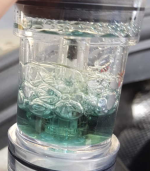Acquired a Swedish Volvo XC60 from Italy, and the coolant level indicator, indicating to stop the engine, flashes sometimes.
Typically, after experiencing a traffic jam in the city, such congestion does not occur outside urban areas.
The level decreases below the minimum, then upon opening the cover of the coolant reservoir, it rises again.
It also occurs on an incline or during turns. I must stop, remove the cap, the liquid rises, and subsequently, no more warning message appears.
I have replaced the head gasket, reconditioned the cylinder head, rebuilt the radiator, put fresh coolant, and altered the distribution.
I am not losing coolant; it only drops below the minimum level during traffic congestion or on inclines/declines, and when I open the cap, it returns to the appropriate level.
The pressure test did not reveal any abnormalities.
Is there a method to put a temperature sensor for this engine? because I lack a temperature indication on the dashboard.
Thank you.
Typically, after experiencing a traffic jam in the city, such congestion does not occur outside urban areas.
The level decreases below the minimum, then upon opening the cover of the coolant reservoir, it rises again.
It also occurs on an incline or during turns. I must stop, remove the cap, the liquid rises, and subsequently, no more warning message appears.
I have replaced the head gasket, reconditioned the cylinder head, rebuilt the radiator, put fresh coolant, and altered the distribution.
I am not losing coolant; it only drops below the minimum level during traffic congestion or on inclines/declines, and when I open the cap, it returns to the appropriate level.
The pressure test did not reveal any abnormalities.
Is there a method to put a temperature sensor for this engine? because I lack a temperature indication on the dashboard.
Thank you.


